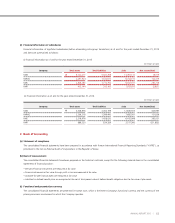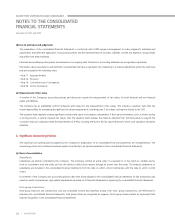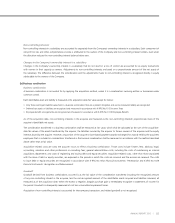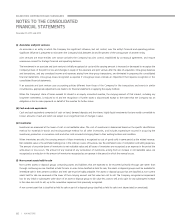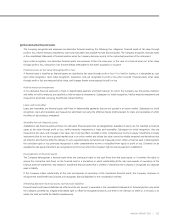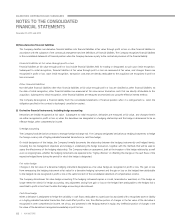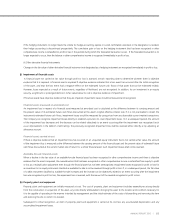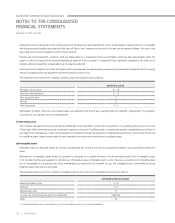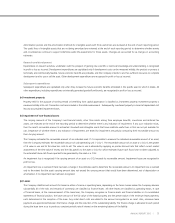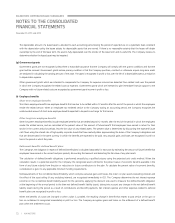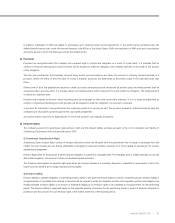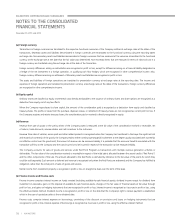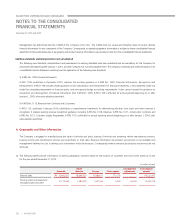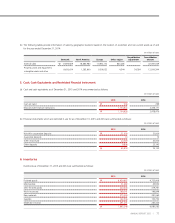Kia 2015 Annual Report Download - page 74
Download and view the complete annual report
Please find page 74 of the 2015 Kia annual report below. You can navigate through the pages in the report by either clicking on the pages listed below, or by using the keyword search tool below to find specific information within the annual report.
(h) Non-derivative financial liabilities
The Company classifies non-derivative financial liabilities into financial liabilities at fair value through profit or loss or other financial liabilities in
accordance with the substance of the contractual arrangement and the definitions of financial liabilities. The Company recognizes financial liabilities
in the consolidated statements of financial position when the Company becomes a party to the contractual provisions of the financial liability.
Financial liabilities at fair value through profit or loss
Financial liabilities at fair value through profit or loss include financial liabilities held for trading or designated as such upon initial recognition.
Subsequent to initial recognition, financial liabilities at fair value through profit or loss are measured at fair value, and changes therein are
recognized in profit or loss. Upon initial recognition, transaction costs that are directly attributable to the acquisition are recognized in profit or
loss as incurred.
Other financial liabilities
Non-derivative financial liabilities other than financial liabilities at fair value through profit or loss are classified as other financial liabilities. At
the date of initial recognition, other financial liabilities are measured at fair value minus transaction costs that are directly attributable to the
acquisition. Subsequent to initial recognition, other financial liabilities are measured at amortized cost using the effective interest method.
The Company derecognizes a financial liability from the consolidated statements of financial position when it is extinguished (i.e. when the
obligation specified in the contract is discharged, cancelled or expires).
(i) Derivative financial instruments, including hedge accounting
Derivatives are initially recognized at fair value. Subsequent to initial recognition, derivatives are measured at fair value, and changes therein
are either recognized in profit or loss or, when the derivatives are designated in a hedging relationship and the hedge is determined to be an
effective hedge, other comprehensive income.
(i) Hedge accounting
The Company holds derivative contracts to manage foreign exchange risk. The Company designated derivatives as hedging instruments to hedge
the foreign currency risk of highly probable forecasted transactions (a cash flow hedge).
On initial designation of the hedge, the Company formally documents the relationship between the hedging instrument(s) and hedged item(s),
including the risk management objectives and strategy in undertaking the hedge transaction, together with the methods that will be used to
assess the effectiveness of the hedging relationship. The Company makes an assessment, both at the inception of the hedge relationship as well
as on an ongoing basis, whether the hedging instruments are expected to be “highly effective” in offsetting the changes in the cash flows of the
respective hedged items during the period for which the hedge is designated.
Fair value hedge
Changes in the fair value of a derivative hedging instrument designated as a fair value hedge are recognized in profit or loss. The gain or loss
from remeasuring the hedging instrument at fair value for a derivative hedging instrument and the gain or loss on the hedged item attributable
to the hedged risk are recognized in profit or loss in the same line item of the consolidated statement of comprehensive income.
The Company discontinues fair value hedge accounting if the hedging instrument expires or is sold, terminated or exercised, or if the hedge no
longer meets the criteria for hedge accounting. Any adjustment arising from gain or loss on the hedged item attributable to the hedged risk is
amortized to profit or loss from the date the hedge accounting is discontinued.
Cash flow hedge
When a derivative is designated to hedge the variability in cash flows attributable to a particular risk associated with a recognized asset or liability
or a highly probable forecasted transaction that could affect profit or loss, the effective portion of changes in the fair value of the derivative is
recognized in other comprehensive income, net of tax, and presented in the hedging reserve in equity. Any ineffective portion of changes in the
fair value of the derivative is recognized immediately in profit or loss.
68 | KIA MOTORS
December 31, 2015 and 2014
KIA MOTORS CORPORATION AND SUBSIDIARIES
NOTES TO THE CONSOLIDATED
FINANCIAL STATEMENTS







